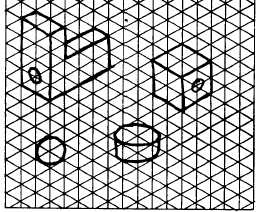SKETCHING
The EA who is able to make quick, accurate
SKETCHES will find this ability a valuable asset
when it comes to conveying technical information
or ideas. Without this ability you are handicapped
in many of your day-to-day situations. Almost
every drawing or graphic problem originates
with a sketch. The sketch becomes an important
thinking instrument, as well as a means of
conversing effectively with technically trained
people. Sketching is not just another trick of the
trade; it is a skill that is essential and should be
an important part of your training. To gain
proficiency in freehand sketching, invite situations
entailing sketching at every opportunity. Do not
worry about your first attempts at sketching;
appearance will improve with experience.
A sketch is usually thought of as being made
freehand, although in practice you may use graph
paper or a small triangle for a straightedge. A
sketch may be of an object or an idea or a
combination of both. Sketches are used to solve
graphic problems before an object or structure
is put in final form on a drawing. Preliminary
sketches are used to plan and organize intelligently
the sheet layout of a complete set of drawings for
a construction project, which often includes many
views and details. There are no set standards for
technical freehand sketching; however, you should
use standard line conventions for clarity.
A sketch may be drawn pictorially so that it
actually looks like the object, or it can be an
orthographic sketch of the object showing
different views. The degree of perfection required
for any sketch will depend upon its intended use.
SKETCHING MATERIALS
One of the main advantages of sketching is
that few materials are required. Basically, you
need only a pencil and paper. However, the type
of sketch prepared and your personal preference
will determine the materials used.
You should use a soft pencil in the grade range
from F to 3H, with H being a good grade for most
sketching. The pencil should be long enough to
permit a relaxed but stable grip. As you gain
experience, you may even prefer to use fine tip
felt pens. (Dark- or bright-colored pens should
be used.) Felt tip pens work very well on overlay
sketches (discussed later).
Most of your sketches will be done on scratch
paper, which can be any type or size of paper.
An experienced draftsman will keep a pad of 3 in.
by 5 in. or 5 in. by 8 in. scratch paper handy at
all times. For planning the layout of a
drawing, you will find tracing paper to be
convenient.
The advantage of sketching on
tracing paper is the ease with which sketches
can be modified or redeveloped simply by
placing transparent paper over previous sketches
or existing drawings. Sketches prepared in
this manner are referred to as OVERLAY
SKETCHES. Cross-section or graph paper may
be used to save time when you are required to
draw sketches to scale. (See fig. 5-56.) Isometric
sketches are easily done on specially ruled
isometric paper. (See fig. 5-57.)
An eraser maybe used, but you will probably
do very little erasing. Sketches usually can be
Figure 5-56.-Use of cross-sectional paper in technical
sketching.
Figure 5-57.-Use of specially ruled isometric paper in
technical sketching.
5-29




